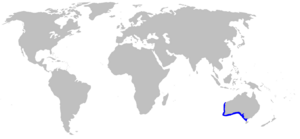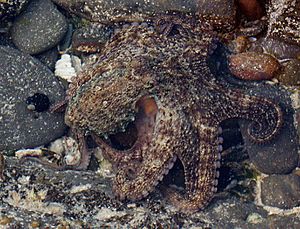Whiskery shark facts for kids
The whiskery shark (Furgaleus macki) is a type of houndshark. It's the only shark in its genus. This common shark lives off the coast of Australia. You can find it from Western Australia all the way to the Bass Strait. It usually stays in waters up to 220 meters (720 ft) deep.
This shark lives near the bottom of the ocean. It likes rocky areas and places with lots of plants. The whiskery shark has a strong body and looks a bit "humpbacked." You can tell it apart from other sharks in its family because it has long, whisker-like feelers called barbels near its nose. It has two medium-sized dorsal fins that are about the same size. Its back is brownish-gray, and its belly is lighter. Young sharks have darker spots and stripes, which fade as they get older. This shark can grow up to 1.6 meters (5.2 ft) long.
Whiskery sharks mostly eat octopuses. They give birth to live young, just like mammals. Female sharks have litters of 4 to 28 pups every two years. Pups are born between August and October. Their pregnancy lasts about 7 to 9 months. This shark is harmless to people. Its meat is sold as "flake" in Australia. It's mainly caught by a special gillnet fishery in Western Australia. In the 1970s and early 1980s, too much fishing caused their numbers to drop. But new rules in the mid-1980s helped the population recover. Now, the whiskery shark population is stable or growing. Because of this, the International Union for the Conservation of Nature says it is of least concern.
Quick facts for kids Whiskery shark |
|
|---|---|
 |
|
| Conservation status | |
| Scientific classification | |
| Genus: |
Furgaleus
|
| Species: |
macki
|
 |
|
| Range of the whiskery shark | |
| Synonyms | |
|
Fur macki Whitley, 1943 |
|
Contents
Shark Family Tree: Taxonomy and History
A scientist named Gilbert Percy Whitley first described the whiskery shark. He named it Fur macki in 1943. Later, in 1951, he changed the name to Furgaleus. This was because the name Fur was already used for a type of fly. The first whiskery shark studied was a young male, 50 cm (20 in) long. It was caught near Mordialloc in Victoria, Australia.
Other names for this shark include Mack's whiskery shark, reef shark, shakey shark, and sundowner. Sharks found in the western part of Australia were once thought to be a different species. But studies showed they were the same as F. macki.
Scientists group Furgaleus with other sharks like Hemitriakis. This grouping helps us understand how different shark species are related.
What Does a Whiskery Shark Look Like?
The whiskery shark has a fairly strong body. It often looks a bit "humpbacked." Its snout, or nose, is short and rounded. This shark is special because it's the only houndshark with long, thin barbels near its nostrils. These barbels look like whiskers.
Its eyes are oval-shaped and sit high on its head. They have small protective eyelids. There's a small hole behind each eye called a spiracle. The shark's mouth is wide and curved. It has grooves at the corners. Whiskery sharks have many rows of teeth. Each upper tooth is sharp and angled, like a knife. Lower teeth have a single upright point. They also have five pairs of gill slits.
The first dorsal fin is quite large. It's closer to the pectoral fins than the pelvic fins. The second dorsal fin is about the same size as the first. It sits slightly in front of the anal fin. The anal fin is much smaller than the dorsal fins. The caudal fin (tail fin) has a short lower part. It also has a deep notch near the tip of the upper part.
Adult whiskery sharks are brownish-gray on top and lighter underneath. Young sharks are lighter. They have darker spots and stripes on their bodies and fins. These markings fade as the shark gets older. This species can grow up to 1.6 meters (5.2 ft) long. It can weigh up to 13 kg (29 lb).
Where Whiskery Sharks Live
The whiskery shark lives only in Australia. It prefers temperate waters on the continental shelf. You can find it from the North West Cape in Western Australia down to Wynyard in Tasmania. It's most common in the southwestern part of its range. This is between Kalbarri and Albany. It's not as common off Victoria and Tasmania. Scientists believe all these sharks belong to one large group. They live close to the ocean bottom, in depths up to 220 meters (720 ft). They like rocky areas and places with lots of kelp (large seaweeds).
Life and Habits: Biology and Ecology
The whiskery shark is an active hunter. It mostly eats octopuses. Sometimes, it also eats other cephalopods (like squid), bony fishes, small rock lobsters, and even seagrass. A tapeworm called Calliobothrium pritchardae is known to be a parasite of this shark.
Like other houndsharks, the whiskery shark gives birth to live young. This is called viviparous. The baby sharks grow inside the mother. They get food from a yolk sac. Male sharks can mate every year. But female sharks reproduce every two years. Mating happens in August and September. Females can store sperm until the next year. Then, the eggs are ready to be released into the uterus.
After a pregnancy of 7 to 9 months, litters of 4 to 28 pups are born. The average litter has 19 pups. Larger females tend to have more pups. Newborn sharks are about 22 to 27 cm (8.7 to 10.6 in) long.
Young whiskery sharks are rarely caught by fishing boats. This might mean that their nursery areas are in deeper waters or places where fishing doesn't happen. Pups grow very fast in their first 15 to 17 months. They continue to grow quickly until they are 3 to 4 years old. Both male and female sharks become mature when they are about 1.1 to 1.3 meters (3.6 to 4.3 ft) long. This usually happens around five years old for males and seven years old for females. Once mature, sharks don't grow much more. This is because their energy goes into having babies. Whiskery sharks can live for about 15 years.
Whiskery Sharks and People
The whiskery shark is not dangerous to humans. People fish for it to eat its meat. It's one of the shark species sold as "flake" in Australia. This shark is caught by a special shark fishery in Western Australia. This fishery also targets other sharks like the dusky shark and the gummy shark.
The fishery started in the 1940s. But whiskery sharks weren't caught much until the 1970s. This was when new fishing gear, like monofilament gillnets, became common. Catches were highest in the early 1980s. About 400 to 600 tons were caught each year. Too much fishing caused the population to drop a lot by the mid-1980s. This led the Western Australian government to create a plan to manage the fishing. This plan helped the shark population stabilize.
In 1995, the fishery wanted to help the whiskery shark population grow even more. They aimed to increase it to 40% of its original size by 2010/11. This goal wasn't fully met on time. But data shows that the population is now increasing. In 2004/05, whiskery sharks made up 12% of the total catch by weight. This species is also caught in smaller numbers by another fishery. But this doesn't threaten the overall population.
Because its population is stable and carefully watched, the International Union for Conservation of Nature has listed this species as of least concern.
Images for kids
See also
 In Spanish: Furgaleus macki para niños
In Spanish: Furgaleus macki para niños







